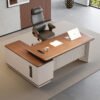How to Improve the Adaptability of Office Space in Office Buildings
Zhehan Furniture
In the modern business environment, office buildings are not only workplaces but also important spaces for enterprises to flexibly respond to market changes and enhance employee efficiency and creativity. With the continuous expansion of business and the transformation of work models, improving the adaptability of office space in office buildings has become crucial. Here are some effective methods:
1. Flexible Space Layout Design
Adopt an open – space planning concept, reduce the use of fixed walls, and use flexible partitioning means such as movable partitions and glass partitions to achieve free combination and adjustment of space. This can quickly divide functional areas such as meeting rooms, office areas, and rest areas according to different work needs, improving space utilization. For example, when an enterprise needs to hold a large meeting, multiple small office areas can be combined into a large meeting space; when focused work is required, the space can be divided into independent office units through partitions.
2. Application of Multifunctional Furniture
Choose multifunctional furniture such as foldable conference tables, height – adjustable desks, and modular sofas. These furniture can not only meet the needs of different work scenarios but also be flexibly adjusted according to space changes. For example, foldable conference tables can be put away when not in use to save space; height – adjustable desks allow employees to adjust their working height according to their needs, improving comfort and work efficiency. In addition, modular sofas can be combined into different shapes and layouts, suitable for various scenarios such as rest and negotiation.
3. Integration of Intelligent Systems
Introduce intelligent systems such as intelligent lighting, intelligent air conditioning, and intelligent security to achieve intelligent management of office space in office buildings. Through intelligent systems, environmental parameters such as lighting, temperature, and humidity can be automatically adjusted according to different time periods, work scenarios, and personnel needs, improving employee comfort and work efficiency. At the same time, intelligent systems can also realize real – time monitoring and management of space usage, providing more accurate space planning and management basis for enterprises.
4. Implementation of Green and Environmental Protection Concepts
In the design and decoration process of office buildings, implement green and environmental protection concepts, use environmentally friendly materials and energy – saving equipment to create a healthy and comfortable office environment. A green and environmentally friendly office building can not only improve the physical health and work efficiency of employees but also reduce the operating costs of enterprises and enhance the social image of enterprises. For example, using environmentally friendly decoration materials can reduce the release of indoor pollutants and improve indoor air quality; using energy – saving equipment can reduce energy consumption and carbon emissions.
5. Creation of Personalized Spaces
Each enterprise has its own unique culture and brand image, and the design of office space in office buildings should fully reflect the personalized needs of enterprises. Through the creation of personalized spaces, such as corporate logo displays, characteristic decorations, and theme conference rooms, employee belonging and identity can be enhanced, and the brand image of enterprises can be improved. For example, enterprises can set up display walls in office areas to show the development history, honor achievements, and product results of the enterprise; set up theme decorations in conference rooms to reflect the culture and values of the enterprise.
In conclusion, improving the adaptability of office space in office buildings requires starting from multiple aspects such as space layout, furniture application, intelligent systems, green environmental protection, and personalized creation, and combining the actual needs and development strategies of enterprises to create a flexible, efficient, comfortable, and environmentally friendly office space.
Recent Posts
- How to Improve the Adaptability of Office Space in Office Buildings
- Zhehan CEO Desk/President Desk / L-shaped Executive Desk: Redefining the Benchmark for High-End Office Furniture
- Create the Ultimate Flexible Lifestyle | ZHEHAN’s [Adjustable Mobile Desk] Unlocks Work, Entertainment, and Reading in One



![Create the Ultimate Flexible Lifestyle | ZHEHAN’s [Adjustable Mobile Desk] Unlocks Work, Entertainment, and Reading in One](https://hrofficechair.com/wp-content/uploads/2025/05/20-1-100x100.jpg)
